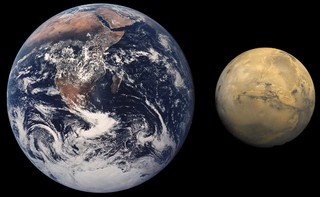Mars, the fourth planet from the sun, is a fascinating celestial body often compared to Earth. But just how big is Mars compared to the other planets in our solar system? This article delves into the size of the red planet, examining its diameter, circumference, mass, and notable surface features, providing a comprehensive understanding of its dimensions in a cosmic context.
 Mars is about half the size of Earth in diameter.
Mars is about half the size of Earth in diameter.
Mars compared to Earth in terms of diameter.
Measuring Mars: Diameter and Circumference
While appearing spherical, Mars, like Earth, bulges slightly at its equator due to rotation. This makes it an oblate spheroid. Its equatorial diameter is approximately 4,222 miles (6,794 km), while its polar diameter is about 4,196 miles (6,752 km). This difference highlights the planet’s non-spherical shape. For comparison, Earth’s diameter is roughly twice as large.
The circumference of Mars also varies depending on the measurement location. Around the equator, it measures roughly 13,300 miles (21,343 km). Measured pole-to-pole, the circumference is about 13,200 miles (21,244 km). These figures underscore the impact of the planet’s rotation on its overall shape.
Mass and Gravity on Mars
Mars’s mass is significantly less than Earth’s, calculated at 6.42 x 10^23 kilograms, about one-tenth of Earth’s mass. This difference in mass results in a weaker gravitational pull. The surface gravity on Mars is only about 38% of Earth’s. A person weighing 100 pounds on Earth would weigh a mere 38 pounds on Mars. This lower gravity has significant implications for potential human exploration and colonization.
Martian Extremes: Olympus Mons and Valles Marineris
Mars boasts dramatic surface features, including the solar system’s largest volcano and deepest canyon. Olympus Mons, a massive shield volcano, towers approximately 17 miles (27 kilometers) high, three times the height of Mount Everest. Its vast base stretches 370 miles (600 kilometers) in diameter, comparable to the size of the state of New Mexico.
Contrasting this towering peak is Valles Marineris, a colossal canyon system stretching over 2,500 miles (4,000 kilometers) long and reaching depths of up to 6 miles (10 kilometers). This immense valley system spans roughly one-fifth of Mars’s circumference, making it significantly larger than Earth’s Grand Canyon.
Mars in Perspective: Size Compared to Other Planets
Mars is the second smallest planet in our solar system, only Mercury being smaller. It’s roughly half the size of Earth and considerably smaller than the gas giants like Jupiter and Saturn. While larger than Earth’s moon, it is dwarfed by the sheer scale of the outer planets. This relative size comparison places Mars in a unique position within our solar system.
Conclusion: A Small but Significant Planet
While Mars is smaller than many other planets in our solar system, its unique characteristics, including its diverse geology and potential for harboring past or present life, make it a focal point of scientific exploration. Understanding its size and features is crucial to unraveling the mysteries of this intriguing red planet and its place in the broader cosmic landscape.
